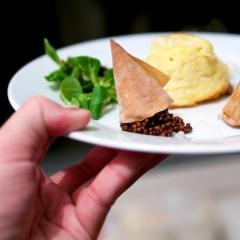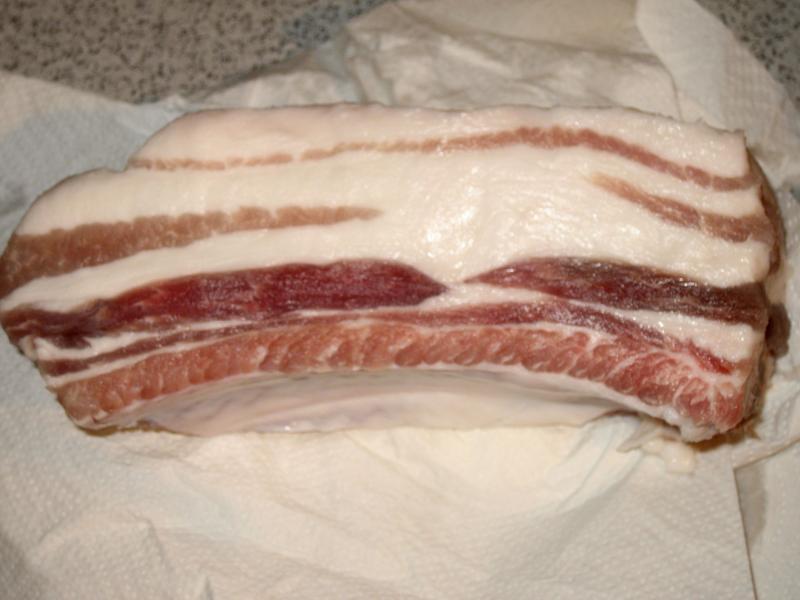-
Posts
346 -
Joined
-
Last visited
Content Type
Profiles
Forums
Store
Help Articles
Posts posted by pep.
-
-
I've seen the HotmixPro Creative on German website for EUR 3500.- excl. VAT (19 %). The Thermomix costs ~ 1000.- incl. VAT. Of course, the capabilities of the HM are much more advanced.
-
I was concerned that the super bag might be too fine as I don't want a clear liquid, but I'll try a 400 & 250 poly filter bag from McMaster Carr.
Personally, I find the 100 µm superbags to be too coarse to get a clear liquid. Works fine to remove ground pepper, however.
-
See FDA's Refrigerator & Freezer Storage Chart -> 7 days will be OK in the fridge.
Thanks everyone! I was leaning towards simple refrigeration already. However, one small question, PedroG: Where do you get the 7 days from that chart?
-
If the meal is only 2 days away and your refrigerator is moderately cold, I'd say that you're fine leaving in the fridge as is. I would probably wrap each portion in a few layers of plastic wrap and leave in the fridge...
Ah. By "portioned" I meant to infer that I vacuum sealed them again afterwards.
-
Pork belly question: I've cooked (~45 hours at 62°) and individually portioned the pork belly. The meal is on Saturday. Should I
- freeze the portioned belly today and put it into the fridge to thaw tomorrow evening,
- re-pasteurize at least the surface of the portions by dipping them into not-quite boiling water (followed by an ice bath of course) and keep them in the fridge until Saturday,
- or, should I dispense with all that and keep them in the fridge as-is?
Edit: Added picture of the pork belly after brining.
- freeze the portioned belly today and put it into the fridge to thaw tomorrow evening,
-
I'm preparing some pork belly for "pork feast" next weekend.
As a first course, I'm planning to do rillettes based on this recipe, but substituting some left-over pâté spice mixture for everything except the juniper berries and garlic. Oh, and I omit the fatback, as my belly is from a mangalitsa pig and not lean at all. And of course I'm cooking the cubes sous-vide. Based on the confit recommendations, I'm trying 82 °C overnight. Or should I use a lower temperature? I just put it in, so it's not yet heated through completely.
The main dish will be sous-vide pork belly with a teriyaki glaze (from Ferran Adria's Family Meal) and some separately prepared crunchy skin. I don't have Instacure #1 (the pink salt available in stores over here only has nitrates, not nitrites, so I can't easily substitute and I don't have the time to do a long cure), so I will be using the basic MC brine with 7 % salt and 3 % sugar (to 100 % water). What brining time should I calculate for two 800-900 g pieces (instead of the whole 2.4 kg belly in MC)?
-
We pretty much only have veal (<10 months) or "añojo" (<18 months) in Spain butcher's. No beef.
According to EU regulations, veal has to be 8 months or younger ("category V"). There is also a second category "Z" for bovine animals between 8 and 12 months, which may get a distinct labeling or not (for example, in Austria it's "Jungrind" or "young beef", while in the UK the same meat is marketed simply as "beef").
In Spain, the corresponding labels are "ternera blanca" and "ternera". I assume "añojo" is an older designation? In Austria, the situation is somewhat similar. Most supermarket beef is so-called "Jungrind" and usually between 10 and 12 months old. However, the meat is already red in color, clearly different from veal.
-
I'm making the banana puree from the Banana Yogurt Recipe (sans centrifuge).
It calls for cooking the bananas sous vide for 12 minutes @ 190 deg F. Is that time from immersion, or from when the temp comes back up to 190?
AFAIK the cooking time is always measured from when the temperature has stabilized again.
-
Has anyone tried the doing the Garlic Confit with twist-off jars? Over here, those are what you use for jams and canning. Old-style canning jars (similar to US mason jars, but with glass lids) are still available, but not common anymore. I made the Garlic Confit on Sunday according to the recipe (including a partial "untwisting" of the lid), but with twist-off jars. Two jars sealed correctly, a third jar popped-open when I tried if it was securely closed and the fourth jar opened when I touched it. A bit of the oil got into the water during cooking, but not much.
Would it have been better to vacuum seal the jars before cooking (in the chamber vacuum sealer)?
-
(Ingredients in the sauce were morels, morel-infused cream, cognac, and tarragon.)
Did you discard the morels used for the infusion or were they included in the sauce?
-
MC states that resting is mainly to allow the juices to cool and thereby thicken (think gelatin) a bit before cutting. I can't remember the page, though.
-
Why make "fake" cherries at all?
Because real cherries don't come with a foie gras filling

-
Boy, did you just open a can of worms!
People like Blackp and Pedrog and I have been all over these issues over the last year.
. . . . .
If you are going to be cooking the food immediately, then the only thing that really matters is whether the bag floats or not, so 98% or higher is probably fine.
. . . . .
Remember last April's discussion The vacuum level dilemma with chamber sealers for sous vide cooking and an earlier post on floating bags. With residual air from low vacuum levels in a chamber vac, or with fatty food, use marbles or glass beads in the bag and skewer suspension to avoid floating. For delicate food like fish you might use an edge sealer or Ziploc bags instead of a chamber vac.
I do remember those discussions. Basically, that means that no-one has compiled a list of recommendations yet? I guess I've got a task set out for me then!
-
Has anyone put together a table with recommended vacuum levels for various applications (bagging fresh meat, fish, liquids; vacuum compression etc.)? The MC chapter on chamber vacuum sealers has several suggestions sprinkled in the text itself, but AFAIK no single table combining the “best guesses”.
The manual for my VC999 K2 contains the following suggested settings:
- fresh meat: 99.6 percent (+ boiling point sensor at 4.0 sensitivity)
- Charcuterie/cheese: 99.6 (2.0)
- Cooked food: 95.0 (2.0)
- Cold liquids: 99.0 (0.5)
For the boiling point sensor in my machine, 0.5 is the maximum sensitivity, 10.0 the lowest sensitivity.
- fresh meat: 99.6 percent (+ boiling point sensor at 4.0 sensitivity)
-
The Artisan is very easy to repair (even if like me you are not a skilled mechanic). The service manual is available for download at MendingShed.com. The replacement part you need is the worm gear and some new grease (and possibly a new gasket, depending on how old your machine is). A tin of grease should last you for at least three repairs.
-
Keep in mind that even bothering to track, let alone publish errata is rare in the cookbook industry.
Don't get me wrong, I really like the books and I certainly would buy them again! But encouraging high expectations with the website and forum and then not quite managing to meet those expectations is a bit of a letdown.
If they PDF version can't be updated easily or automatically, I think it should be removed or labeled as out of date. If there is a "Last revised" date given on a page, it should be accurate (for ease of maintenance, such a date should always be generated automatically). This is all just good web practice.
-
I think the website version (rather than the PDF) is newer: at least, the two corrections I sent in last week are up there.
So they just don't bother to update the "Last revised:" date? That's confusing (and someone should really generate a new PDF). But certainly better than nothing.
However, I still think that a list of corrections that actually made it into the second printing is long overdue (or some kind of markup in the main list).
-
So what's up with the errata? The current list is almost a year old and there is not even a list for the second printing. I asked in the MC forum last October (after I got my book set - the first printing wasn't available in Europe), but I got no response from the MC team. I have to say I'm a bit disappointed with the errata policy and the lack of response to my question.
-
Can anyone whos been in contact with cuisine technology /polyscience tell me how they did it, and what their response time was? Ive tried both the form on their webpage and email, but still no answer 10 days later.
I wrote a mail to culinary@polyscience.com in April 2011 and had a reply within a day. Once contact was established (I live in Europe, so a haven't got a clue what timezone they are in), messages went back and forth every 5 minutes or so and the issue was quickly resolved.
-
No, it is a closed and very simple unit. On the other hand, there may be a combination of keys that would make it possible.
But there is nothing in the manual? With the Polyscience Sous Vide Professional, it's a certain combination of key presses during power on (which was described incorrectly in the manual).
-
Can you configure a temperature offset for the units thermometer?
-
The jamon looks gorgeous, but even vacuum packed, I'm not certain how it would survive the (admittedly shortish) flight. On the other hand, since my boyfriend is reading this, he's probably going to return several punds heavier.
I don't think the flight would be a problem if he just took with him in one piece instead of sliced.
-
I still can't commit 2 hours to pressure cook a jar but a whole caramelized garlic clove sounds delicious.
You can cook more than one jar of course. And the confit is not only cooked, but canned, so it's shelf-stable. Just do a bunch of jars at the same time and use those two hours to make a years worth of garlic confit

Are you sure it will be shelf stable? I would be very cautious about canning garlic.
According to the MC team and at the given pressure, yes, unless you are high up in the mountains. I don't know whether someone has calculated the necessary sterilization time for European pressure cookers, though (0.8 bar vs. 15 psi).
-
Dried (and possibly smoked) peppers come to mind. Be careful however, the very decorative braids sold at the Boqueria can harbor insects such as the Bread beetle. Unfortunately those beetles even like smoked hot peppers

Today I would vacuum seal the peppers, but unfortunately that was not an option three years ago. so in the end, the peppers had to go (apparently even freezing didn't kill all the eggs, as the beetles returned after the peppers had been in the freezer for a month).
Of course, you shouldn't forget the Cava





"Modernist Cuisine" by Myhrvold, Young & Bilet (Part 3)
in Cookbooks & References
Posted
+1 by volume & printing!